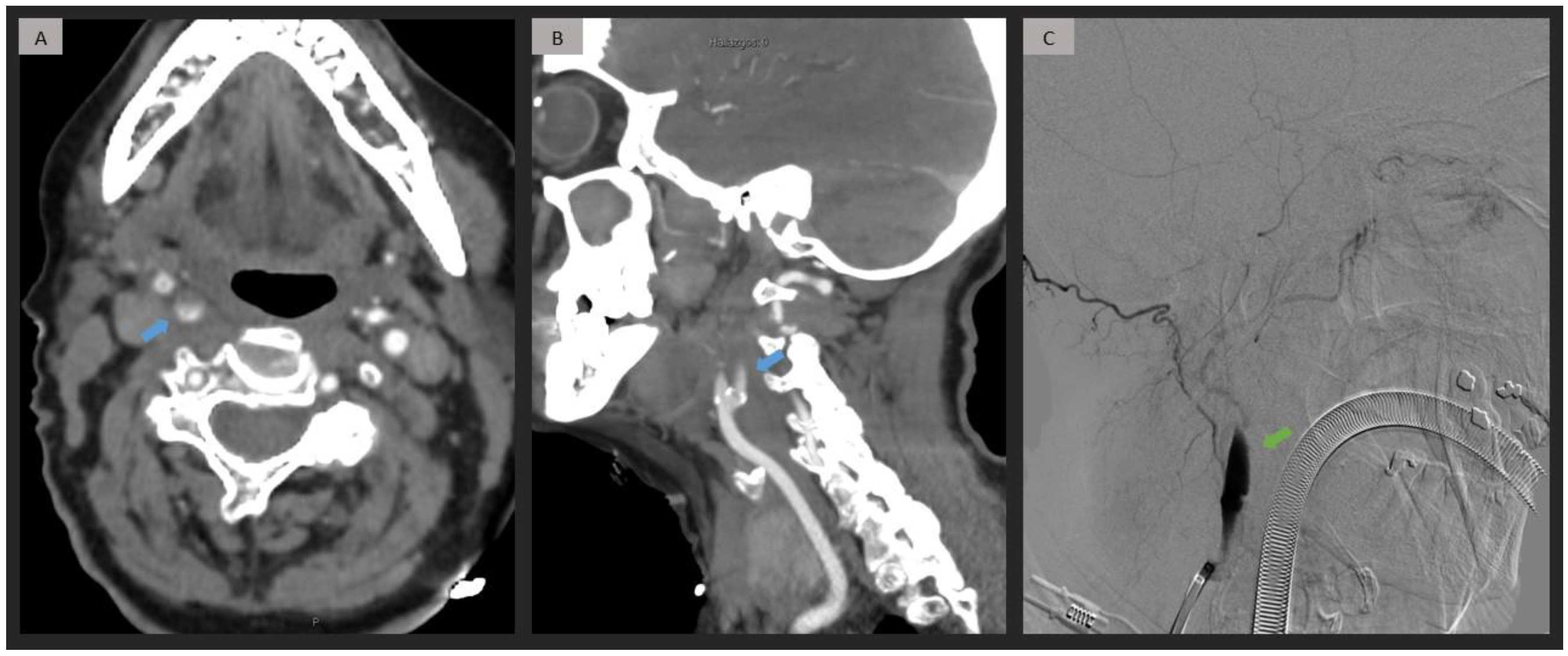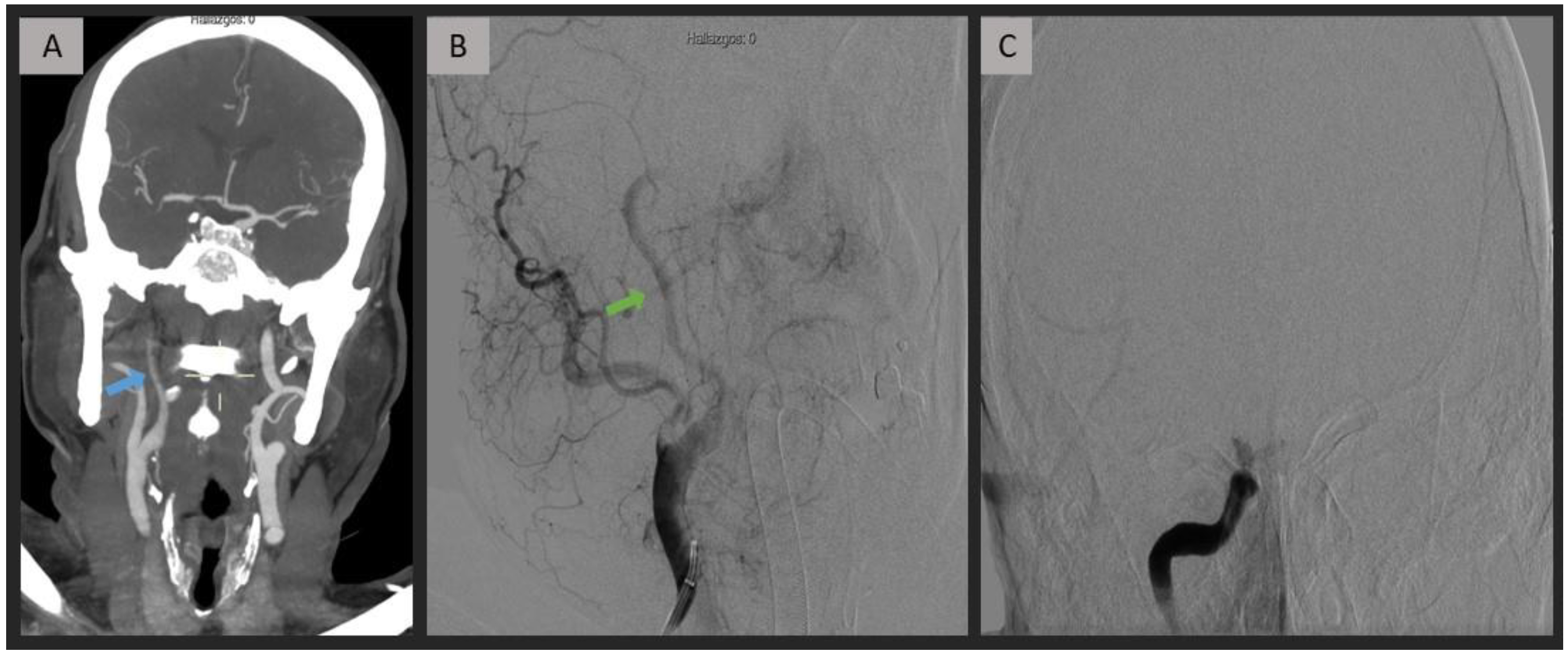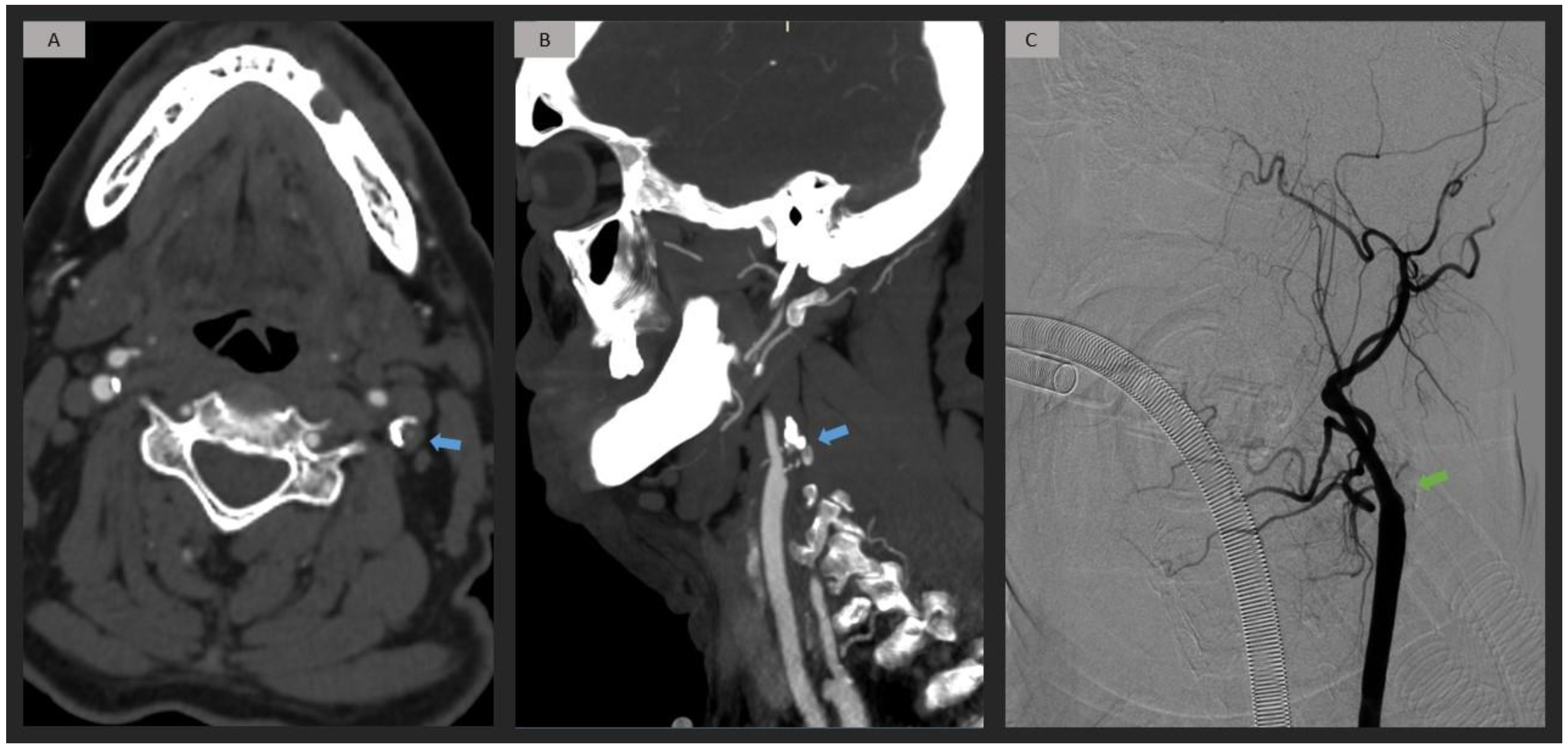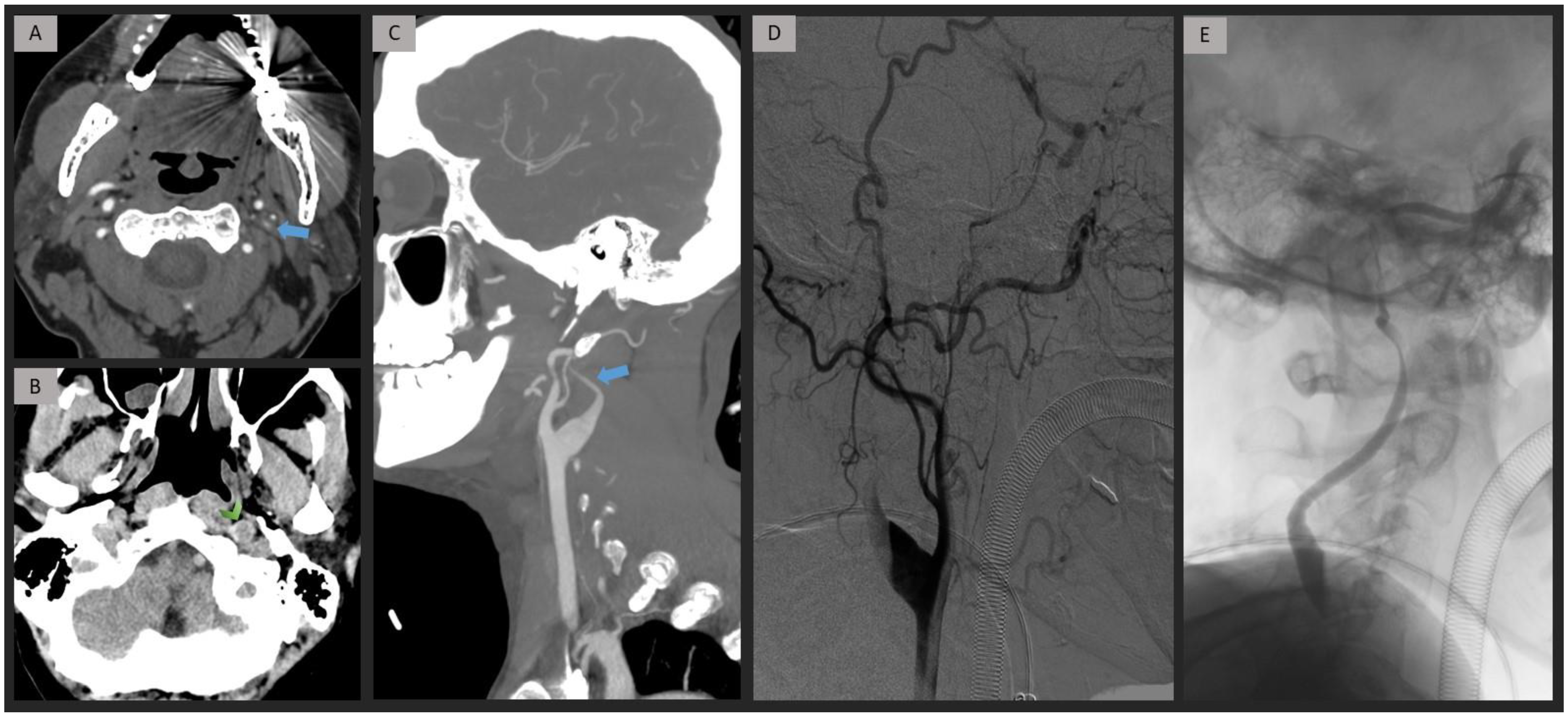Accuracy of Computed Tomography Angiography for Diagnosing Extracranial Mural Lesions in Patients with Acute Internal Carotid Artery Occlusion: Correlation with Digital Subtraction Angiography
Abstract
:1. Introduction
2. Materials and Methods
2.1. Study Design
2.2. Patient Selection
2.3. Image Acquisition Protocol
2.4. CTA Analysis
2.5. DSA Analysis
2.6. Demographic Variables, Comorbidities, and Clinical Severity
2.7. Statistical Analysis
3. Results
4. Discussion
5. Conclusions
Author Contributions
Funding
Institutional Review Board Statement
Informed Consent Statement
Data Availability Statement
Conflicts of Interest
References
- Berkhemer, O.A.; Fransen, P.S.S.; Beumer, D.; van den Berg, L.A.; Lingsma, H.F.; Yoo, A.J.; Schonewille, W.J.; Vos, J.A.; Nederkoorn, P.J.; Wermer, M.J.H.; et al. A Randomized Trial of Intraarterial Treatment for Acute Ischemic Stroke. N. Eng. J. Med. 2015, 372, 11–20. [Google Scholar] [CrossRef] [PubMed] [Green Version]
- Albers, G.W.; Marks, M.P.; Kemp, S.; Christensen, S.; Tsai, J.P.; Ortega-Gutierrez, S.; McTaggart, R.A.; Torbey, M.T.; Kim-Tenser, M.; Leslie-Mazwi, T.; et al. Thrombectomy for Stroke at 6 to 16 Hours with Selection by Perfusion Imaging. N. Eng. J. Med. 2018, 378, 708–718. [Google Scholar] [CrossRef] [PubMed]
- Nogueira, R.G.; Jadhav, A.P.; Haussen, D.C.; Bonafe, A.; Budzik, R.F.; Bhuva, P.; Yavagal, D.R.; Ribo, M.; Cognard, C.; Hanel, R.A.; et al. Thrombectomy 6 to 24 Hours after Stroke with a Mismatch between Deficit and Infarct. N. Engl. J. Med. 2018, 378, 11–21. [Google Scholar] [CrossRef]
- Goyal, M.; Demchuk, A.M.; Menon, B.K.; Eesa, M.; Rempel, J.L.; Thornton, J.; Roy, D.; Jovin, T.G.; Willinsky, R.A.; Sapkota, B.L.; et al. Randomized Assessment of Rapid Endovascular Treatment of Ischemic Stroke. N. Eng. J. Med. 2015, 372, 1019–1030. [Google Scholar] [CrossRef] [Green Version]
- Malhotra, K.; Goyal, N.; Tsivgoulis, G. Internal Carotid Artery Occlusion: Pathophysiology, Diagnosis, and Management. Curr. Atheroscler. Rep. 2017, 19, 41. [Google Scholar] [CrossRef]
- Rocha, M.; Delfyett, W.T.; Agarwal, V.; Aghaebrahim, A.; Jadhav, A.; Jovin, T.G. Diagnostic accuracy of emergency CT angiography for presumed tandem internal carotid artery occlusion before acute endovascular therapy. J. NeuroInterv. Surg. 2018, 10, 653–656. [Google Scholar] [CrossRef]
- Bradac, G.B.; Venturi, F.; Stura, G.; Coriasco, M.; Ventilii, G.; Garabello, D.; Bergui, M. Considerations about Occlusion of the Intracranial Distal Internal Carotid Artery. Clin. Neuroradiol. 2017, 27, 169–174. [Google Scholar] [CrossRef]
- Bradac, G.B.; Venturi, F.; Bosco, G.; Garabello, D.; Coriasco, M.; Stura, G.; Ventilii, G.; Bergui, M.; Cerrato, P. Acute Occlusion of the Distal Internal Carotid Artery: Single Center Experience in 46 Consecutive Cases, review of the literature and proposal of a classification. Clin. Neuroradiol. 2020, 30, 67–76. [Google Scholar] [CrossRef] [PubMed]
- Baz, R.A.; Scheau, C.; Niscoveanu, C.; Bordei, P. Morphometry of the Entire Internal Carotid Artery on CT Angiography. Medicina 2021, 57, 832. [Google Scholar] [CrossRef]
- Kaszczewski, P.; Elwertowski, M.; Leszczyński, J.; Ostrowski, T.; Kaszczewska, J.; Gałązka, Z. Intracranial Flow Volume Estimation in Patients with Internal Carotid Artery Occlusion. Diagnostics 2022, 12, 766. [Google Scholar] [CrossRef] [PubMed]
- Kappelhof, M.; Marquering, H.A.; Berkhemer, O.A.; Borst, J.; van der Lugt, A.; van Zwam, W.H.; Vos, J.A.; Lycklama, À.; Nijeholt, G.; Majoie, C.B.L.M.; et al. Accuracy of CT Angiography for Differentiating Pseudo-Occlusion from True Occlusion or High-Grade Stenosis of the Extracranial ICA in Acute Ischemic Stroke: A Retrospective MR CLEAN Substudy. AJNR Am. J. Neuroradiol. 2018, 39, 892–898. [Google Scholar] [CrossRef] [PubMed] [Green Version]
- Liebig, T.; Gralla, J.; Schroth, G. Endovascular Treatment of Acute Stroke: Evolution and Selection of Techniques and Instruments Based on Thrombus Imaging. Clin. Neuroradiol. 2015, 25 (Suppl. S2), 299–306. [Google Scholar] [CrossRef] [PubMed] [Green Version]
- Waters, M.J.; McMullan, P.; Mitchell, P.J.; Kleinig, T.J.; Churilov, L.; Scroop, R.; Dowling, R.J.; Bush, S.J.; Nguyen, M.; Yan, B. Endovascular Therapy Versus Medical Therapy for Acute Stroke Attributable to Isolated Cervical Internal Carotid Artery Occlusion Without Intracranial Large Vessel Occlusion. Stroke Vasc. Interv. Neurol. 2022, 2, 174. [Google Scholar] [CrossRef]
- Tsang, A.C.O.; Orru, E.; Klostranec, J.M.; Yang, I.H.; Lau, K.K.; Tsang, F.C.P.; Lui, W.M.; Pereira, V.M.; Krings, T. Thrombectomy Outcomes of Intracranial Atherosclerosis-Related Occlusions: A Systematic Review and Meta-Analysis. Stroke 2019, 50, 1460–1466. [Google Scholar] [CrossRef] [PubMed]
- Powers, W.J.; Rabinstein, A.A.; Ackerson, T.; Adeoye, O.M.; Bambakidis, N.C.; Becker, K.; Biller, J.; Brown, M.; Demaerschalk, B.M.; Hoh, B.; et al. Guidelines for the Early Management of Patients with Acute Ischemic Stroke: 2019 Update to the 2018 Guidelines for the Early Management of Acute Ischemic Stroke: A Guideline for Healthcare Professionals from the American Heart Association/American Stroke Association. Stroke 2019, 50, e344–e418, Erratum in Stroke 2019, 50, e440–e441. [Google Scholar] [CrossRef] [PubMed]
- Menon, B.K.; Campbell, B.C.V.; Levi, C.; Goyal, M. Role of Imaging in Current Acute Ischemic Stroke Workflow for Endovascular Therapy. Stroke 2015, 46, 1453–1461. [Google Scholar] [CrossRef]
- Kayan, M.; Demirtas, H.; Türker, Y.; Kayan, F.; Çetinkaya, G.; Kara, M.; Çelik, A.O.; Umul, A.; Yılmaz, Ö.; Aktaş, A.R. Carotid and cerebral CT angiography using low volume of iodinated contrast material and low tube voltage. Diagn. Interv. Imaging 2016, 97, 1173–1179. [Google Scholar] [CrossRef]
- Demirpolat, G.; Yüksel, M.; Kavukçu, G.; Tuncel, D. Carotid CT angiography: Comparison of image quality for left versus right arm injections. Diagn. Interv. Radiol. 2011, 17, 195–198. [Google Scholar]
- Lee, S.J.; Liu, B.; Rane, N.; Mitchell, P.; Dowling, R.; Yan, B. Correlation between CT angiography and digital subtraction angiography in acute ischemic strokes. Clin. Neurol. Neurosurg. 2021, 200, 106399. [Google Scholar] [CrossRef]
- Choi, J.H.; Jang, J.; Koo, J.; Ahn, K.-J.; Shin, Y.S.; Kim, B.-S. Multiphasic Computed Tomography Angiography Findings for Identifying Pseudo-Occlusion of the Internal Carotid Artery. Stroke 2020, 51, 2558–2562. [Google Scholar] [CrossRef]
- Khumtong, R.; Krings, T.; Pereira, V.M.; Pikula, A.; Schaafsma, J.D. Comparison of multimodal CT scan protocols used for decision-making on mechanical thrombectomy in acute ischemic stroke. Neuroradiology 2020, 62, 399–406. [Google Scholar] [CrossRef]
- Carrafiello, G.; De Lodovici, M.; Piffaretti, G.; Rivolta, N.; Ierardi, A.; Petrillo, M.; Facchinetti, A.; Carimati, F.; Verrengia, E.; Mauri, M.; et al. Carotid artery stenting: Influence of experience and cerebrovascular risk factors on outcome. Diagn. Interv. Imaging 2014, 95, 421–426. [Google Scholar] [CrossRef] [PubMed] [Green Version]
- Wareham, J.; Crossley, R.; Barr, S.; Mortimer, A. Cervical ICA pseudo-occlusion on single phase CTA in patients with acute terminal ICA occlusion: What is the mechanism and can delayed CTA aid diagnosis? J. Neurointerv. Surg. 2018, 10, 983–987. [Google Scholar] [CrossRef]
- Grossberg, J.A.; Haussen, D.C.; Cardoso, F.B.; Rebello, L.C.; Bouslama, M.; Anderson, A.M.; Frankel, M.R.; Nogueira, R.G. Cervical Carotid Pseudo-Occlusions and False Dissections. Stroke 2017, 48, 774–777. [Google Scholar] [CrossRef] [PubMed]
- Ha, S.W.; Lee, C.-H.; Kim, H.S.; Yeon, E.K.; Lee, S.J.; Shin, B.-S.; Kang, H.G. Factors Distinguishing Proximal and Distal Internal Carotid Artery Occlusions in Patients with Acute Ischemic Stroke. Diagnostics 2022, 12, 494. [Google Scholar] [CrossRef]
- Prakkamakul, S.; Pitakvej, N.; Dumrongpisutikul, N.; Lerdlum, S. Mid-cervical flame-shaped pseudo-occlusion: Diagnostic performance of mid-cervical flame-shaped extracranial internal carotid artery sign on computed tomographic angiography in hyperacute ischemic stroke. Neuroradiology 2017, 59, 989–996. [Google Scholar] [CrossRef] [PubMed]
- Manrique-Zegarra, M.; García-Pastor, A.; Castro-Reyes, E.; Guzmán-De-Villoria, J.A.; Herrera, I.H.; Morro, I.G.; Diéguez, M.D.V.; Gil, F.F.; Cantero, J.G.; Lorente, J.S. CT angiography for diagnosis of carotid near-occlusion: A digital subtraction angiography validation study. Neuroradiology 2022, 64, 1729–1735. [Google Scholar] [CrossRef]
- Lim, J.; Magarik, J.A.; Froehler, M.T. The CT-Defined Hyperdense Arterial Sign as a Marker for Acute Intracerebral Large Vessel Occlusion. J. Neuroimaging 2018, 28, 212–216. [Google Scholar] [CrossRef]
- Labeyrie, M.-A.; Civelli, V.; Reiner, P.; Aymard, A.; Saint-Maurice, J.-P.; Zetchi, A.; Houdart, E. Prevalence and treatment of spontaneous intracranial artery dissections in patients with acute stroke due to intracranial large vessel occlusion. J. NeuroInterv. Surg. 2018, 10, 761–764. [Google Scholar] [CrossRef]
- Ben Hassen, W.; Machet, A.; Edjlali-Goujon, M.; Legrand, L.; Ladoux, A.; Mellerio, C.; Bodiguel, E.; Gobin-Metteil, M.-P.; Trystram, D.; Rodriguez-Regent, C.; et al. Imaging of cervical artery dissection. Diagn. Interv. Imaging 2014, 95, 1151–1161. [Google Scholar] [CrossRef] [Green Version]
- Hanning, U.; Sporns, P.B.; Schmiedel, M.; Ringelstein, E.B.; Heindel, W.; Wiendl, H.; Niederstadt, T.; Dittrich, R. CT versus MR Techniques in the Detection of Cervical Artery Dissection. J. Neuroimaging 2017, 27, 607–612. [Google Scholar] [CrossRef]
- Kim, H.; Kwak, H.S.; Chung, G.H.; Hwang, S.B. Differentiating pseudo-occlusion from true occlusion of proximal internal carotid artery in acute ischemic stroke on CT angiography. Clin. Neurol. Neurosurg. 2019, 185, 105495. [Google Scholar] [CrossRef] [PubMed]
- Mughal, M.M.; Khan, M.K.; DeMarco, J.K.; Majid, A.; Shamoun, F.; Abela, G.S. Symptomatic and asymptomatic carotid artery plaque. Expert Rev. Cardiovasc. Ther. 2011, 9, 1315–1330. [Google Scholar] [CrossRef] [PubMed]
- Garg, A.; Farooqui, M.; Zevallos, C.B.; Quispe-Orozco, D.; Mendez-Ruiz, A.; Zaidat, O.; Ortega-Gutierrez, S. Carotid artery angioplasty versus stenting for management of acute tandem occlusions. J. Neurol. Sci. 2021, 428, 117588. [Google Scholar] [CrossRef]
- Rodrigues, M.; Cunha, A.; Figueiredo, S.; Carvalho, A.; Veloso, M.; Barros, P.; Gregório, T.; Paredes, L.; Pinho, J.; Castro, S.; et al. Emergent carotid artery stenting in atherosclerotic disease of the internal carotid artery with tandem intracranial occlusion. J. Neurol. Sci. 2018, 15, 196–198. [Google Scholar] [CrossRef] [PubMed]
- Poppe, A.; Jacquin, G.; Roy, D.; Stapf, C.; Derex, L. Tandem Carotid Lesions in Acute Ischemic Stroke: Mechanisms, Therapeutic Challenges, and Future Directions. AJNR Am. J. Neuroradiol. 2020, 41, 1142–1148. [Google Scholar] [CrossRef]
- Lacidogna, G.; Pitocchi, F.; Mascolo, A.P.; Marrama, F.; D’agostino, F.; Rocco, A.; Mori, F.; Maestrini, I.; Sabuzi, F.; Cavallo, A.; et al. CT Perfusion as a Predictor of the Final Infarct Volume in Patients with Tandem Occlusion. J. Pers. Med. 2023, 13, 342. [Google Scholar] [CrossRef] [PubMed]
- Fernández-Gómez, M.; Gallo-Pineda, F.; Hidalgo-Barranco, C.; Amaya-Pascasio, L.; Deltoro-Pérez, C.; Martínez-Sánchez, P.; Castro-Luna, G. Acute intracranial internal carotid artery occlusion: Extension and location of the thrombus as an influencing factor in Computed Tomography angiography findings. Eur. J. Radiol. Open 2023, 10, 100462. Available online: https://linkinghub.elsevier.com/retrieve/pii/S2352047722000697 (accessed on 7 December 2022). [CrossRef] [PubMed]




| TE Group (n= 42) | CML Group (n = 52) | p-Value * | |
|---|---|---|---|
| Male sex, n, (%) | 18 (42.8%) | 43 (82.3%) | <0.001 |
| Age, median (IQR), years | 74 (20) | 66 (15) | 0.008 |
| Arterial Hypertension, n, (%) | 28 (66.7%) | 34 (65.4%) | 0.658 |
| Diabetes Mellitus, n, (%) | 10 (23.8%) | 17 (32.7%) | 0.497 |
| Dyslipidemia, n, (%) | 13 (31%) | 28 (53.8%) | 0.06 |
| Previous Atrial Fibrillation, n, (%) | 14 (33.3%) | 3 (5.8%) | <0.001 |
| Novo Atrial Fibrillation, n, (%) | 6 (14.3%) | 2 (3.8%) | 0.071 |
| Previous CHD, n, (%) | 5 (11.9%) | 5 (9.6%) | 0.740 |
| Previous stroke, n, (%) | 4 (9.5%) | 8 (15.4%) | 0.545 |
| Smoking, n, (%) | 8 (19%) | 32 (61.5%) | <0.001 |
| Alcohol abuse, n, (%) | 5 (11.9%) | 10 (19.2%) | 0.571 |
| NIHSS, median, (IQR) | 18 (6) | 15 (13) | 0.007 |
| Etiology Confirmed on DSA | |||
|---|---|---|---|
| Thromboembolism n = 42 | Atherosclerosis n = 46 | Dissection n = 6 | |
| Location confirmed on DSA | |||
| Origin of the ICA, n, (%) | 9, (21.4%) | 44, (95.6%) | 0, (0%) |
| Cervical, n, (%) | 12, (28.6%) | 1, (2.1%) | 6, (100%) |
| Isolated Intracranial (pseudo-occlusion), n, (%) | 21, (50%) | 1, (2.1%) | 0, (0%) |
| Extracranial occlusion pattern on CTA | |||
| Well-defined occlusion, n, (%) | 9, (21.4%) | 43, (93.5%) | 0, (0%) |
| Flame-shaped pattern, n, (%) | 33, (78.6%) | 3, (6.5%) | 6, (100%) |
| Other radiological sign | |||
| Widening of the cervical segment of ICA, n, (%) | 0, (0%) | 0, (0%) | 4, (66.7%) |
Disclaimer/Publisher’s Note: The statements, opinions and data contained in all publications are solely those of the individual author(s) and contributor(s) and not of MDPI and/or the editor(s). MDPI and/or the editor(s) disclaim responsibility for any injury to people or property resulting from any ideas, methods, instructions or products referred to in the content. |
© 2023 by the authors. Licensee MDPI, Basel, Switzerland. This article is an open access article distributed under the terms and conditions of the Creative Commons Attribution (CC BY) license (https://creativecommons.org/licenses/by/4.0/).
Share and Cite
Fernández-Gómez, M.; Gallo-Pineda, F.; Hidalgo-Barranco, C.; Castro-Luna, G.; Martínez-Sánchez, P. Accuracy of Computed Tomography Angiography for Diagnosing Extracranial Mural Lesions in Patients with Acute Internal Carotid Artery Occlusion: Correlation with Digital Subtraction Angiography. J. Pers. Med. 2023, 13, 1169. https://doi.org/10.3390/jpm13071169
Fernández-Gómez M, Gallo-Pineda F, Hidalgo-Barranco C, Castro-Luna G, Martínez-Sánchez P. Accuracy of Computed Tomography Angiography for Diagnosing Extracranial Mural Lesions in Patients with Acute Internal Carotid Artery Occlusion: Correlation with Digital Subtraction Angiography. Journal of Personalized Medicine. 2023; 13(7):1169. https://doi.org/10.3390/jpm13071169
Chicago/Turabian StyleFernández-Gómez, Miriam, Félix Gallo-Pineda, Carlos Hidalgo-Barranco, Gracia Castro-Luna, and Patricia Martínez-Sánchez. 2023. "Accuracy of Computed Tomography Angiography for Diagnosing Extracranial Mural Lesions in Patients with Acute Internal Carotid Artery Occlusion: Correlation with Digital Subtraction Angiography" Journal of Personalized Medicine 13, no. 7: 1169. https://doi.org/10.3390/jpm13071169
APA StyleFernández-Gómez, M., Gallo-Pineda, F., Hidalgo-Barranco, C., Castro-Luna, G., & Martínez-Sánchez, P. (2023). Accuracy of Computed Tomography Angiography for Diagnosing Extracranial Mural Lesions in Patients with Acute Internal Carotid Artery Occlusion: Correlation with Digital Subtraction Angiography. Journal of Personalized Medicine, 13(7), 1169. https://doi.org/10.3390/jpm13071169







